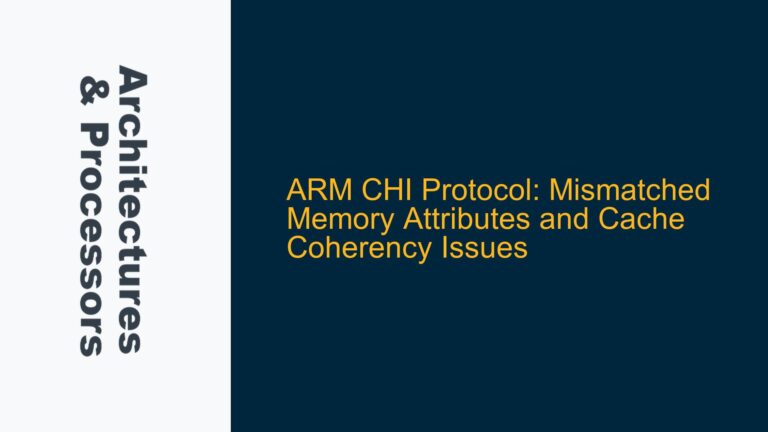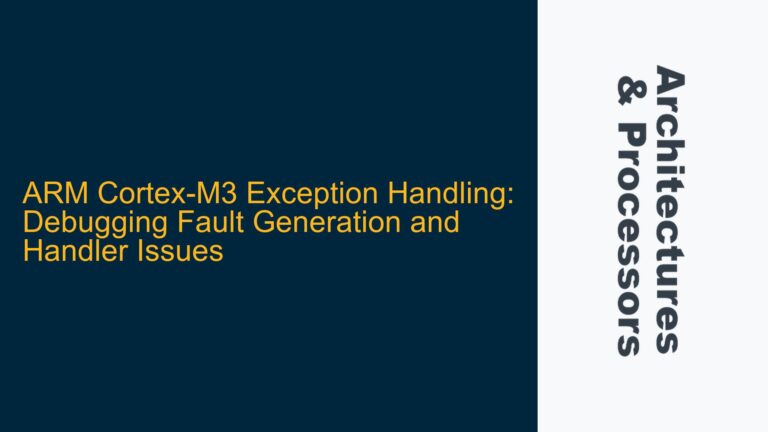GIC Distributor Register Write Latency and Visibility Guarantees
The ARM Generic Interrupt Controller (GIC) is a critical component in ARM-based systems, responsible for managing interrupts across multiple cores and peripherals. One of the key aspects of the GIC architecture is the GIC Distributor, which handles the routing and prioritization of interrupts. When developing systems that rely on the GIC, understanding the latency and synchronization guarantees for writing to GIC Distributor registers is crucial. This is particularly important when ensuring that writes to these registers are visible to all logical components of the GIC, including the CPU interface.
The GIC Distributor registers are memory-mapped, and writes to these registers can have side effects that need to be synchronized across the system. For example, when configuring interrupt priorities or enabling/disabling interrupts, the system must ensure that these changes are fully propagated before proceeding with further operations. The latency of these writes can vary depending on several factors, including the specific System-on-Chip (SoC) implementation, the current state of the system, and the presence of other concurrent operations.
In many cases, developers attempt to define a sensible timeout for these operations, assuming that after a certain period, the write will have completed and its effects will be visible. However, this approach is inherently flawed because the latency can vary significantly depending on the system’s state and configuration. Instead of relying on timeouts, ARM provides mechanisms to explicitly check the completion of register writes, ensuring that the system can proceed with confidence that the operation has been fully executed.
Register Write Pending (RWP) Bits and System Dependency
The primary mechanism for ensuring the completion of GIC Distributor register writes is the use of the Register Write Pending (RWP) bits. These bits are part of the GIC architecture and provide a way to determine when a write to a GIC Distributor register has completed and its side effects have been fully propagated. The RWP bits are particularly useful because they allow the system to wait for the completion of a write without relying on arbitrary timeouts, which can lead to inefficiencies or race conditions.
The RWP bits are set when a write to a GIC Distributor register is initiated and are cleared once the write and its side effects have been fully processed. By polling these bits, the system can determine when it is safe to proceed with further operations that depend on the completion of the write. This approach is more reliable than using timeouts because it directly reflects the state of the GIC hardware, rather than making assumptions about the timing of the write operation.
However, the behavior of the RWP bits and the overall latency of GIC Distributor register writes can still be influenced by several factors. These include the specific implementation of the GIC in the SoC, the presence of other concurrent operations that may affect the GIC’s internal state, and the overall system configuration. For example, in a system with multiple cores and high interrupt traffic, the latency of GIC Distributor register writes may be higher due to contention for shared resources within the GIC.
Additionally, the GIC architecture allows for different implementations that may have varying performance characteristics. Some implementations may prioritize low latency for register writes, while others may optimize for other aspects of interrupt handling. As a result, the exact latency of GIC Distributor register writes can vary between different SoCs, even if they are based on the same ARM architecture.
Implementing RWP Bit Polling and System-Specific Optimizations
To effectively manage the latency and synchronization of GIC Distributor register writes, developers should implement a robust mechanism for polling the RWP bits. This involves writing to the desired GIC Distributor register and then repeatedly checking the RWP bits until they are cleared, indicating that the write has completed. This approach ensures that the system waits only as long as necessary for the write to complete, without relying on arbitrary timeouts.
When implementing RWP bit polling, it is important to consider the potential impact on system performance. In systems with high interrupt traffic or multiple cores, excessive polling of the RWP bits can lead to increased contention for shared resources and reduced overall system performance. To mitigate this, developers should optimize the polling mechanism to minimize the number of checks required and avoid unnecessary delays.
One optimization technique is to use a combination of polling and interrupt-driven mechanisms. For example, the system could poll the RWP bits for a short period and then switch to an interrupt-driven approach if the write has not completed within a certain time frame. This approach reduces the overhead of continuous polling while still ensuring that the write is eventually completed.
Another important consideration is the impact of system configuration on GIC Distributor register write latency. In some cases, the latency may be influenced by the configuration of other system components, such as the memory subsystem or the interconnect fabric. For example, if the GIC is located behind a slow interconnect or if the memory subsystem is heavily loaded, the latency of register writes may increase. In such cases, developers should carefully analyze the system configuration and optimize it to minimize the impact on GIC performance.
In addition to optimizing the polling mechanism and system configuration, developers should also consider the use of other ARM-provided synchronization mechanisms, such as memory barriers and cache management instructions. These mechanisms can help ensure that writes to GIC Distributor registers are properly synchronized with other operations in the system, reducing the risk of race conditions and other synchronization issues.
For example, the Data Synchronization Barrier (DSB) instruction can be used to ensure that all memory accesses before the barrier are completed before any subsequent instructions are executed. This can be particularly useful when writing to GIC Distributor registers, as it ensures that the write is fully propagated before the system proceeds with further operations. Similarly, cache management instructions, such as cache invalidation or cleaning, can be used to ensure that the GIC has a consistent view of memory, reducing the risk of stale data affecting interrupt handling.
In conclusion, managing the latency and synchronization of GIC Distributor register writes is a critical aspect of developing reliable ARM-based systems. By using the RWP bits and implementing system-specific optimizations, developers can ensure that writes to GIC Distributor registers are properly synchronized and that the system can proceed with confidence that the operation has been fully executed. Additionally, by considering the impact of system configuration and using ARM-provided synchronization mechanisms, developers can further optimize the performance and reliability of their systems.






